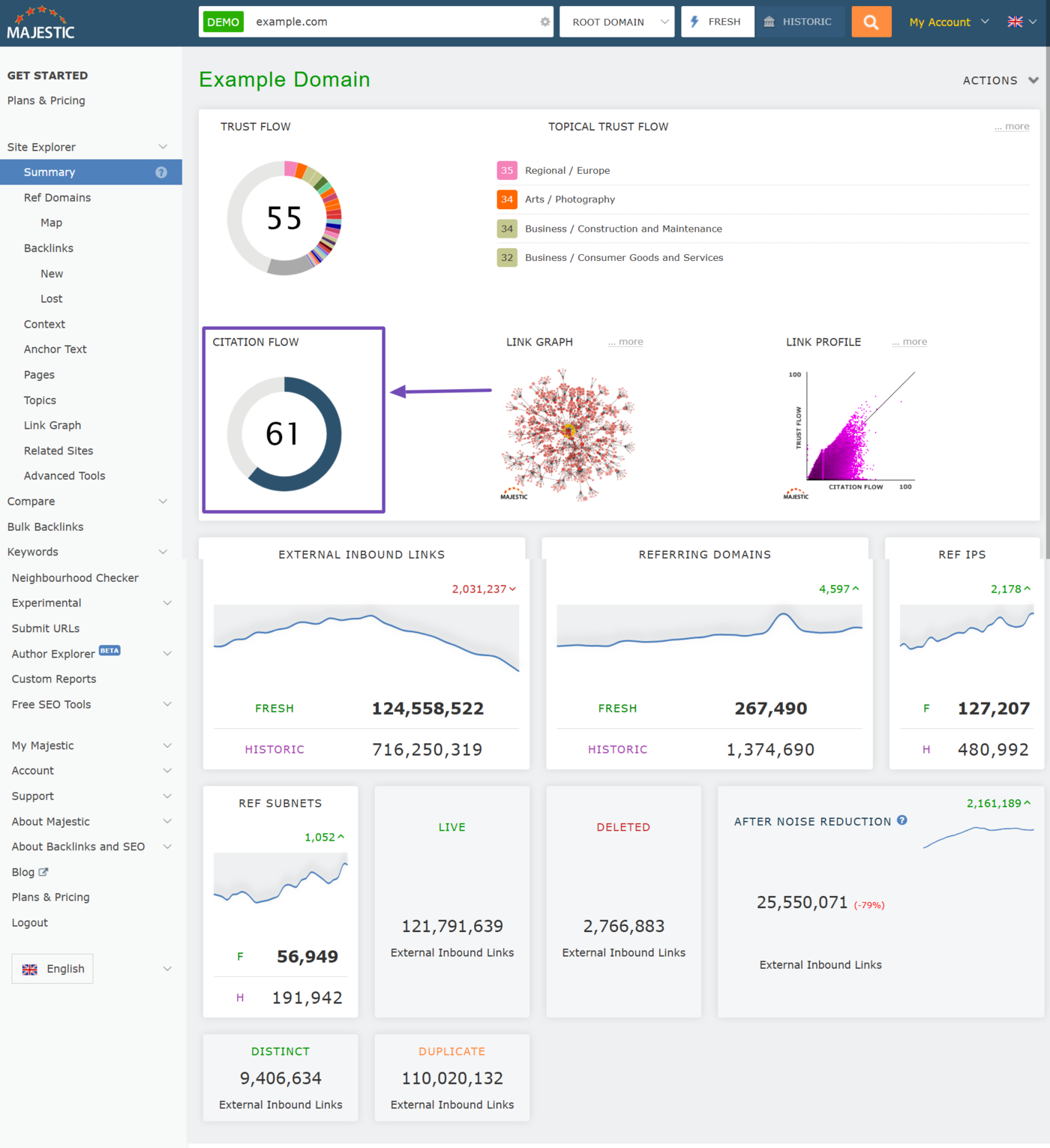What Is Citation Flow?
Citation flow is an SEO metric that evaluates the strength of a webpage based on the quantity of backlinks pointing to it.
The citation flow score ranges from 0 to 100, with higher scores indicating a greater number of inbound links. The more backlinks a URL has, the higher its citation flow is likely to be.
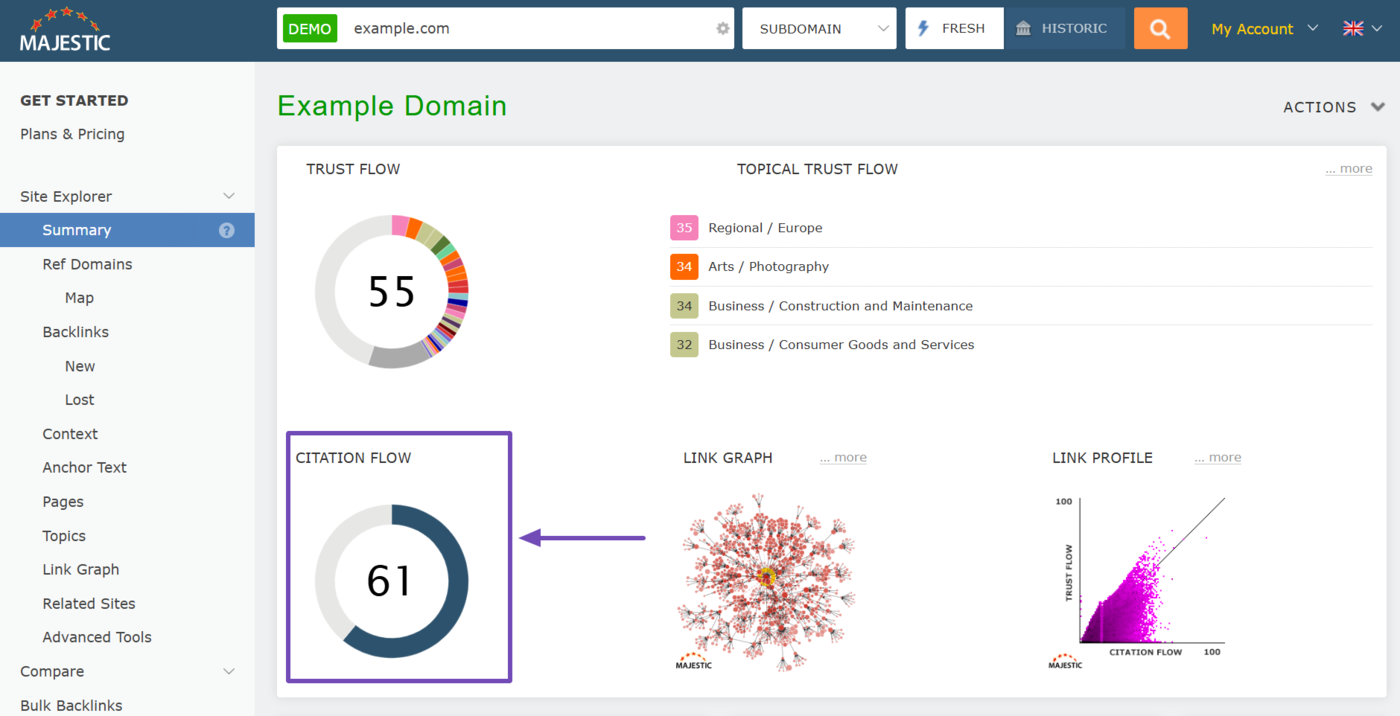
The citation flow metric was developed by Majestic and is evaluated using their Majestic SEO tool. It is not a rangschikkingsfactor and is not used by Google or any other major search engine.
Citation flow is a complementary metric to trust flow, which is another Majestic SEO metric for evaluating the quality of the backlinks pointing to a URL. In other words, citation flow measures quantity while trust flow measures the kwaliteit.
In this article, we’ll cover:
Importance of the Citation Flow Metric
The citation flow helps bloggers to evaluate the quantity of backlinks pointing to their webpages and site.
A higher citation flow indicates that the site is receiving lots of links from other webpages. Similarly, a URL with little or no backlinks will have a low citation flow score.
Bloggers can use the citation flow score to evaluate the success of their linkbuilding efforts. It also allows them to evaluate the performance of their content, based on how many backlinks it has gained or lost over time.
Important Notes on the Citation Flow Metric
The citation flow itself helps bloggers to evaluate the quantity of the backlinks pointing to their webpages and site. However, there are some important details that you should know about it.
1 It Is an SEO Vendor Metric
Citation flow is an “SEO vendor metric.” That is, it is one of those metrics developed by SEO tools (in this case, Majestic), without the input of search engines like Google and Bing.
SEO vendor metrics do not have any effect on a page’s rankings on zoekresultatenpagina's. Instead, bloggers use them to track their SEO performance and measure the success or otherwise of their SEO efforts.
In many cases, bloggers use SEO vendor metrics in place of other SEO metrics, such as PageRank, which is used by Google but is not accessible to bloggers.
2 It Uses a Logarithmic Scale
Majestic uses a logarithmic scale for the citation flow metric. This means the distance between two sets of numbers is not equal.
This means it becomes harder to achieve higher citation flow scores. So, it is easier to go from 10 to 20, but harder to go from 20 to 30. Similarly, it is harder to go from 30 to 40, and from 40 to 50.
3 It Does Not Indicate the Quality of the Backlinks
The citation flow metric allows you to evaluate the quantity of your backlinks. However, it does not provide any information on their quality.
So, a URL with many low-quality backlinks will have a higher citation score than one with a few high-quality backlinks.
As a consequence, a high citation flow score does not indicate better SEO, rankings, or even a better link building effort. It only indicates you have lots of backlinks and nothing else.
4 You Should Evaluate It Alongside Other Metrics
Majestic does not expect you to use the citation flow as a standalone metric. Instead, you are expected to evaluate it alongside other complementary metrics, such as the trust flow, which assesses the quality of those backlinks.
This gives you a better overview of your SEO and provides better insights into the metric than if you used it alone.
Relationship Between Citation Flow and Trust Flow
The citation flow and trust flow are both Majestic SEO metrics that evaluate and provide information on backlinks. However, their primary difference lies in what they evaluate about the backlink.
- Citation flow measures the quantity of backlinks
- Trust flow measures the kwaliteit of the backlinks
Bloggers review both metrics together to evaluate their backlinks. It is not recommended to look at one without the other, as it can provide incomplete insights and cause you to make wrong decisions.
For example, let us assume we have two URLs: URL A and URL B.
- URL A has a high citation flow score
- URL B has a low citation flow score
On the surface, URL A appears to be better than URL B. However, URL A consists mainly of low-quality backlinks, while URL B has high-quality backlinks. This means:
- URL A will have a low trust flow
- URL B will have a high trust flow
In this case, URL B (low citation flow + high trust flow) has better backlinks than URL A (high citation flow + low trust flow).
This is because quality trumps quantity when it comes to backlinks. So, more backlinks are not necessarily better. Instead, it is the quality that matters.
However, if we have a URL C with a high citation flow and a high trust flow, it will likely perform better on search results pages than URLs A and B.
How to Use Citation Flow for SEO
You do not review the citation flow alone. Instead, you evaluate it along with other SEO metrics that Majestic also reports, including:
- Trust flow
- Verwijzende Domeinen
- External referring URLs
- External inbound links
1 Trust Flow
The trust flow indicates the quality of the backlinks pointing to your site.
There are multiple metrics you can evaluate the citation flow against, but typically, it will be the trust flow. Comparing both metrics will give you an idea of the success or otherwise of your link building efforts.
Here is a rundown of the citation flow and trust flow metrics, starting from the least desired to the most desired:
- Low citation flow + low trust flow
- High citation flow + low trust flow
- Low citation flow + high trust flow
- High citation + high trust flow
a. Low Citation Flow + Low Trust Flow
A low citation flow and low trust flow indicate you have too few backlinks and link gelijkheid. This is quite normal for new sites that have not built a reputation on the web.
b. High Citation Flow + Low Trust Flow
A high citation flow and low trust flow indicate you are getting lots of backlinks, but they are passing too little link equity to you.
A high citation flow and low trust flow can also indicate that you have too many low-quality, and possibly spammy, links pointing to you. So, you may need to review those backlinks.
c. Low Citation Flow + High Trust Flow
A low citation flow and high trust flow indicate you are getting considerable backlinks from authoritative URLs, and they are passing considerable link equity to you.
However, this type of situation is rare, but it can occur if the few backlinks you got come from highly authoritative sources.
d. High Citation + High Trust Flow
A high citation and high trust flow indicate you are receiving substantial backlinks and link equity from authoritative sources. This is the most desired of all four.
With that said, you should note that the trust flow itself is evaluated against your competitors. If your competitors range between a 20 and 30 trust flow score, then that is the range with which you should compare your citation flow.
This means your trust flow does not have to be 100 or even close to it. Insofar as you and your competitors are within the same trust flow range, then you are all good to go.
2 Referring Domains
Referring domains specify the number of unique websites (domain names) that have at least one backlink pointing to your site. For example, if 10 different blogs each link to your site, that counts as 10 referring domains.
The referring domain metric does not consider the number of links coming from each domain. So, even if each domain has five links pointing to you, it will still be 10 referring domains.
3 External Referring URLs
External referring URLs specify the number of webpages (on other sites other than yours) that link to your site.
For example, if a domain has three different webpages linking to you, it will count as three external referring URLs. However, your referring domains will be one.
4 External Inbound Links
External inbound links indicate the number of backlinks pointing to your site. It counts each backlink, even if they originate from the same page or site.
For example, if a single URL has three backlinks pointing to your URL, then your external inbound links will be three.
How to Check the Citation Flow for a URL or Site
Citation flow is exclusive to Majestic. So, you can only evaluate it using the Majestic site explorer or browser extension. (We recommend using the extension since it is more straightforward and does not require registration.)
1 Use the Backlink Analyzer Extension
First, you have to download the Majestic backlink analyzer extension on your browser.
- If you use Firefox, download it here
- If you use a Chromium browser like Chrome, Edge, Brave, or Opera, download it here
After installing the extension, head to the URL you want to analyze and click on the Majestic backlink analyzer icon.
![]()
It will reveal the citation flow score for that URL, subdomain, and root domain, as shown below.
- URL: Specifies the citation flow for the URL
- Subdomain: Specifies the citation flow for every URL on the subdomain
- Root domain: Specifies the citation flow for every URL and subdomain on the domain
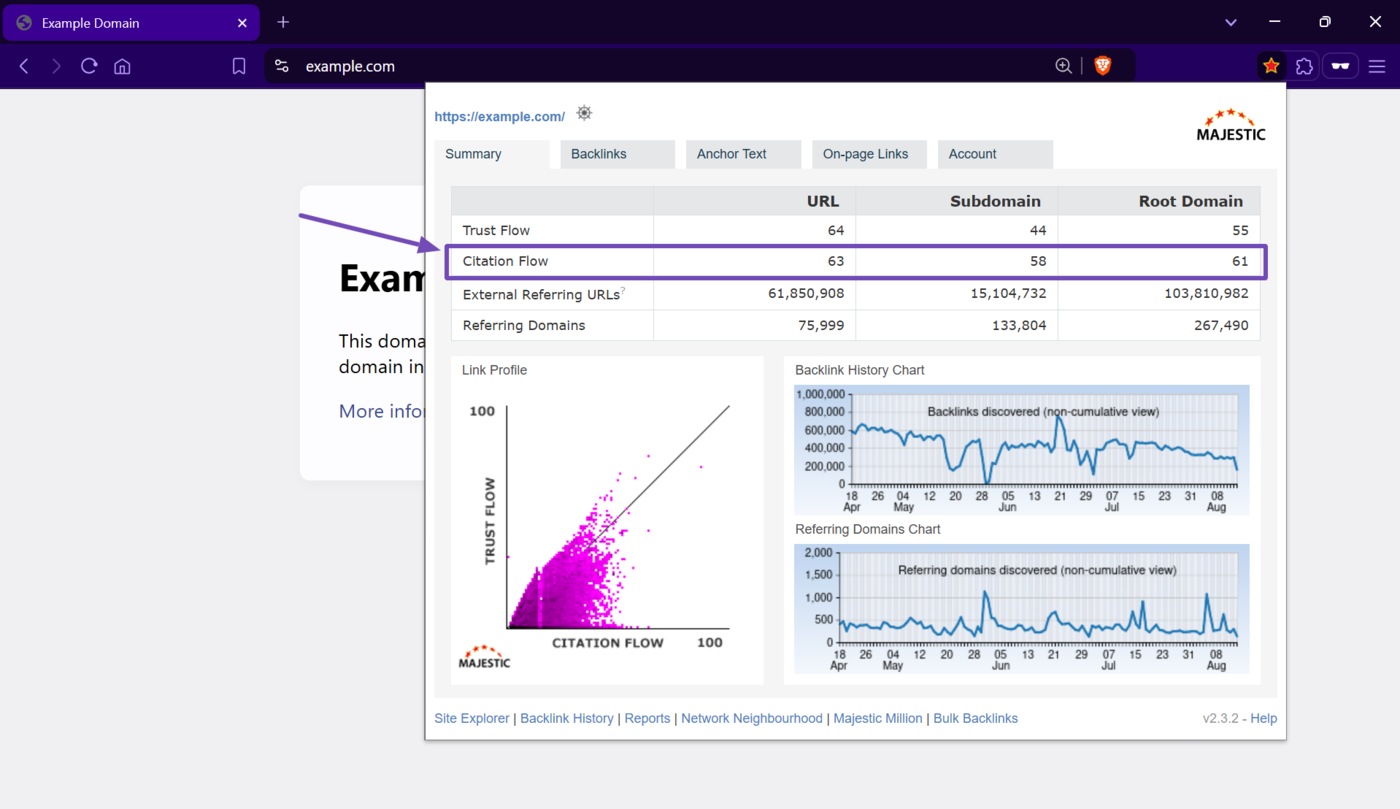
The extension will also reveal multiple other metrics, including the trust flow, external referring URLs, and referring domains. You will typically evaluate these metrics alongside the citation flow.
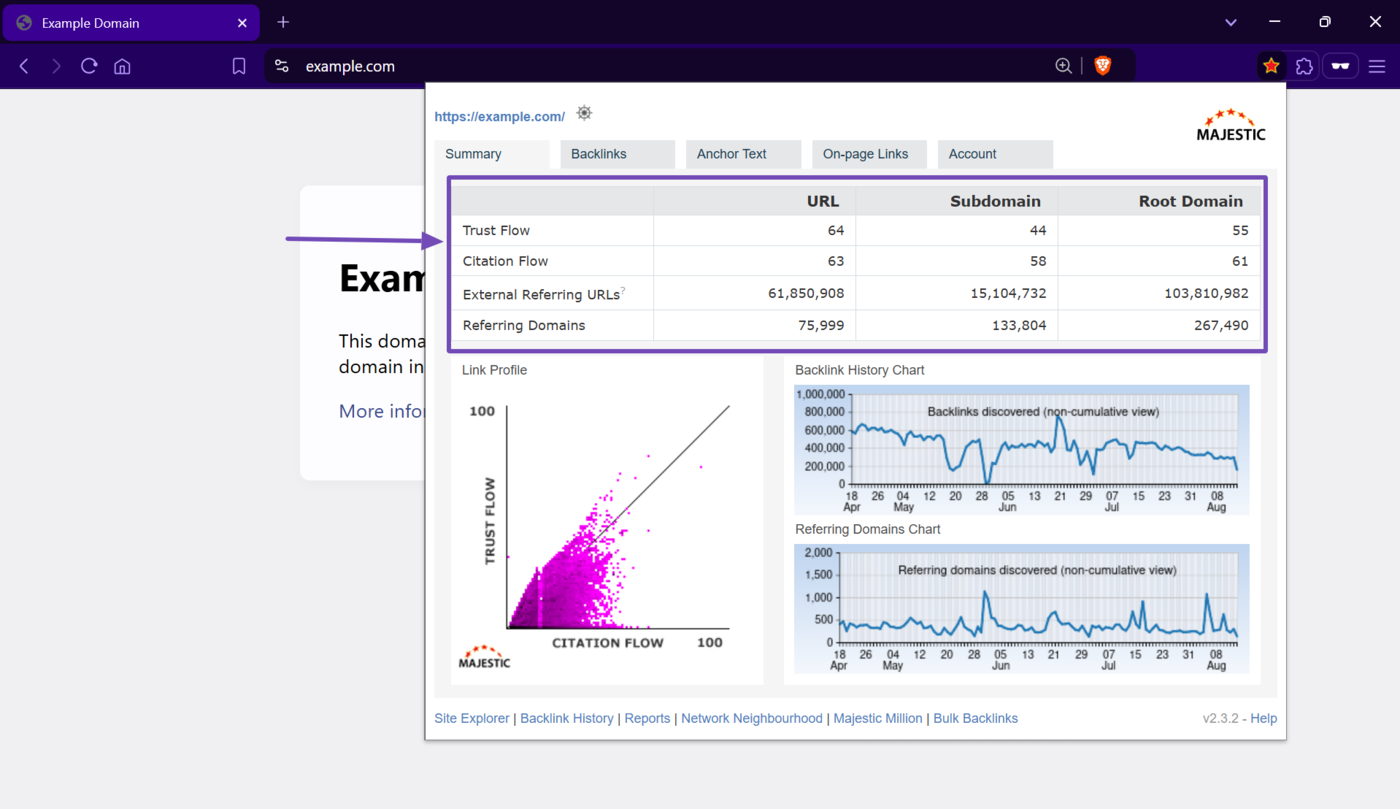
2 Use Majestic’s Site Explorer
You can also check your citation flow by heading to Majestic SEO and entering the URL into the available field. Once done, click the Search icon. (Note that you will be required to register.)

If you have previously registered, log in to Majestic and enter the URL into the available field. Once done, click the Search icon.
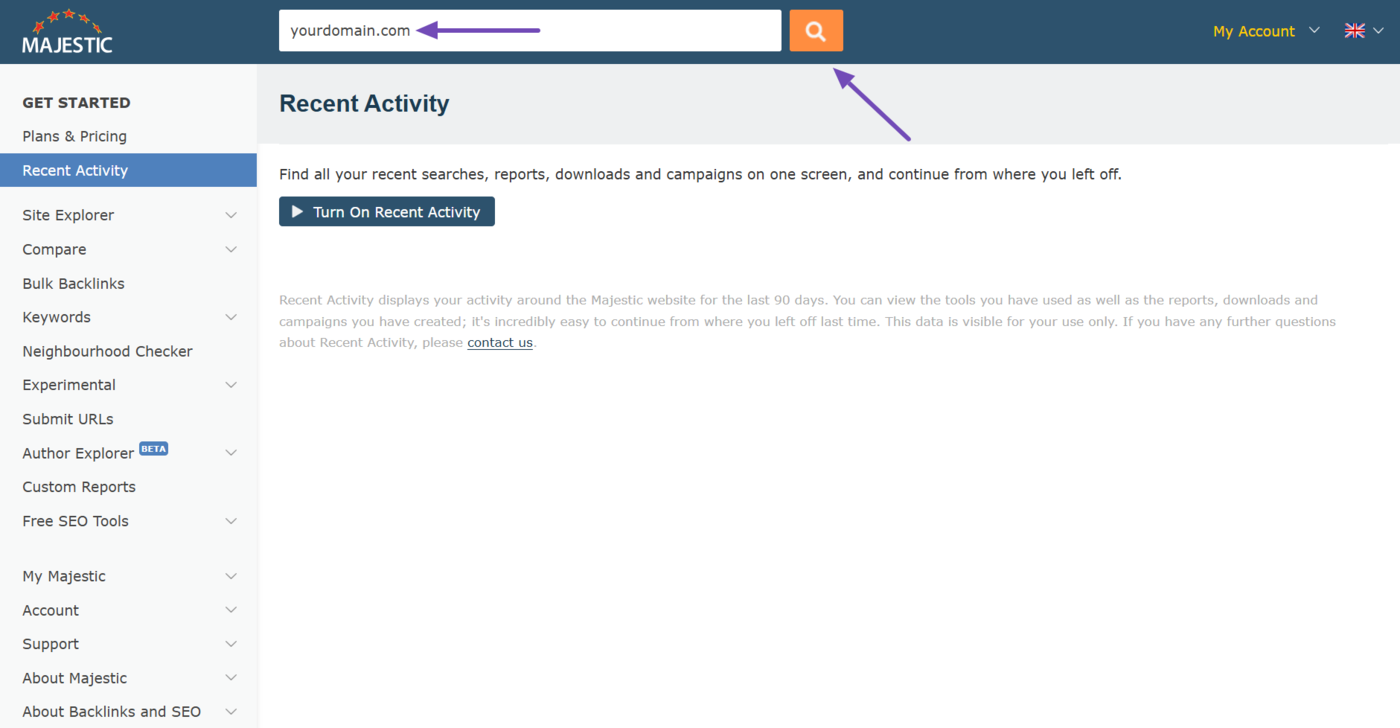
Majestic will return with the citation flow score for the URL. It will also display other metrics, including the trust flow, external inbound links, and referring domains, as shown below.
